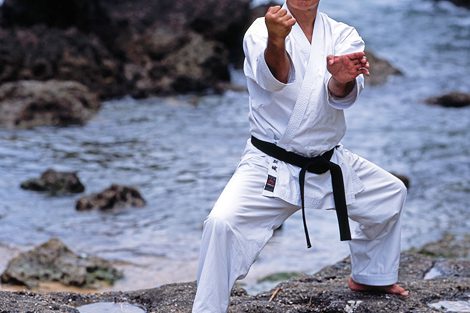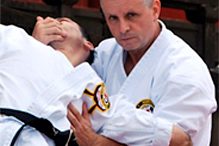The Okinawans love to party.
And Karate masters are no exception.
Actually, if you have read your history, you should know that the red-light district of Naha, Okinawa, had its fair share of regular shady visits from various Karate masters.
It’s true!
Anyway, over to the topic.
At parties people often drink alcoholic beverages, right?
Well, once – a long time ago – I was at some kind of event in Okinawa when I noticed a famous Goju-ryu master drinking a beer. Nothing strange about that. But… he had really much ice in his beer. So, “Sensei, why do you put so much ice in your beer?” was the obvious question.
The reply was something I will never forget.
It was something along the lines of:
“It helps against my hemorrhoids. Too many Sanchin kata, you know, he… he…”
Silence.
“Okay… rewind! Are you telling me that you, a famous, seemingly healthy, 10th dan Goju-ryu master are drinking beer filled to the rim with ice… because it helps against your hemorrhoids?!” was what I wanted to ask. But I just nodded and probably changed topic or something. Like I said, it was a long time ago.
Sanchin.
The kata that Goju-ryu (Uechi-ryu and Isshin-ryu too) basically is built upon. Along with nearly every traditional Kung Fu style out there! It is to Shorei-ryu what Naifanchin/Naihanchin is to Shorin-ryu.
It’s the foundation.
The origins of Sanchin (in Japanese to the right) can even be traced to the breathing exercises performed by Buddhist monks at the original Shaolin Monastery. These breathing exercises were developed by Bodhidharma (Daruma), the transmitter of Zen to China, to provide a regimen for the monks so that they would keep being strong and healthy during their time at the monastery. At least that’s how the story goes.
And this guy got sick from it?
For those that don’t know, hemorrhoids are “swelling and inflammation of veins in the rectum and anus” according to Wikipedia. (A word of warning: Don’t check that Wikipedia article out unless you want a big picture of somebodys hairy behind etched in your mind).
Practising the kata Sanchin is supposed to be healthy for you. To use a more modern language, Sanchin is a isotonic and isometric physical breathing exercise which opens the lungs, capillaries and the epidermal glands, strengthens the heart muscle, massages the lymph system, teaches you correct alignment, tension/relaxation, posture and technique, and a bunch of other things I can’t spell…
Oh, and I almost forgot, it also – evidently – gives you painful lumps in your butt.
So, seen from that perspective, Sanchin is something of a double-edged sword: something that has (or can have) both favorable and unfavorable consequences.
It’s all about how you do it.
Breath in… breath out.
So how should you do it? Well, I thought I could share my thoughts on this.
Let’s start with correct technique for breathing:
Sanchin was “invented” long before Olympic weights and weight training machines were invented. However… the way that these activities are done (weight lifting and Sanchin) can – and definitely should – be identical. The proper breathing in Sanchin (and a bench press for that matter) should not be something known as a Valsalva maneuver.
That’s when you get increased internal pressure and hypertension, and before you know it you will be standing at parties explaining why you have Titanic proportions of ice in your beer to some foreigner.
“Valsalva what?” you might ask. And I’ll explain. But remember, I’m not a doctor in anything. I’m no certified professional physicist. So take my word for what it is.
 (But then again, to draw a parallel, do you need to take courses in “Introduction to Creative Writing”, “Intermediate Creative Writing”, and “Advanced Creative Writing” before writing a poem?)
(But then again, to draw a parallel, do you need to take courses in “Introduction to Creative Writing”, “Intermediate Creative Writing”, and “Advanced Creative Writing” before writing a poem?)
The Valsalva maneuver is performed by forcible exhalation against a closed airway, usually done by closing one’s mouth and/or pinching one’s nose shut. It’s what many people do when diving, to equalize pressure. And it’s what many people do when practising Sanchin kata.
One shouldn’t do the Valsalva maneuver (breath holding) when practising Sanchin, but rather slow, measured breath release. Ideal breathing would simply be a gentle exhale with each technique. Not getting your face all red, with veins popping out of your forehead, which I too often have seen people do.
Using correct breathing means:
- No breath holding exists (which would create the Valsalva maneuver)…
- …and the slightly increased intrathoracic pressure would increase blood flow to the muscles being worked.
You know, I recently saw one of those Ultimate Fighter shows on TV. During a fight one coach was repeatedly screaming “Breath in through your nose! Breath in through your nose!” to his fighter.
“Karate people should learn from that” I immediately thought.
Why?
Because, breath restriction (inhaling through the nose) on inhale gives the “yin” (lowered pressure) to the “yang” of the restricted exhale (raised pressure) which we use in Sanchin kata. Breathing in through your nose lowers the intrathoracic pressure. This increases venous return and subsequently gives the heart more blood to pump out on the exhale.
One should not be done without the other.
Unless you want possible strokes, aneurisms, hernias, or blackouts… along with something painful (and nasty) between your butt cheeks.
But that’s not everything.
To remain healthy when practising Sanchin, there is one more important point to think about, besides breathing correctly.
The final secret is spelled r-e-c-t-a-l s-p-h-i-n-c-t-e-r.
You need to contract your rectal sphincter. To use a more casual language, you need to perform something weight lifters refer to as “the anal lock”. I’m not going any deeper into that (pun intended), you can probably figure out what I mean.
Just squeeze.
Tight!
And don’t release until you have completed your exercise.
So… what else remains? Well, probably a lot. The puzzle of Sanchin takes years to complete. Can it even be completed?
I don’t know.
I actually haven’t trained long enough.
But I do know that knowing your breathing and a certain “lock” will help you a long way. At least if you want to remain healthy.
On the other hand… if you want an interesting topic for party conversations, then go ahead, squeeeze your eyes out. Just don’t say I didn’t warn you!
I heard hemorrhoid cream is cheap nowadays.



22 Comments